#Journal des Dames et des Modes
Text

Umberto Brunelleschi, Fashion illustration, Toilette au goût Vénitien (Venetian Costume), Costumes Parisiens, Journal des dames et des modes, 1913.
Illustration with a design for a "Venetian Outfit", part of the 54th issue of the "Journal des dames et des modes", published in Paris on November 20, 1913. The illustration features a woman wearing a pink jacket with wide hips, decorated with bundles of purple and white flowers, and with white fur borders and pleated sleeves over a yellow blouse with similar floral patterns and gold borders, and a pink, draped, ankle-length, narrow skirt. She wears a Navy style black hat on her head, with a large, black lace veil hanging from it over her shoulders and back, a necklace with a large, round green stone, and lavender shoes with small, golden buckles. (x)
#umberto brunelleschi#illustration#1913#Venetian Outfit#venetian#venetian costume#fashion illustration#costume#costumes parisiens#journal des dames et des modes#art#paris#paris fashions#chic#paris mode#Parisian mode#Parisian fashion#la belle epoque#art nouveau#vintage#antique#vintage costume#1910s costumes#1910s illustrations#1913 illustrations#carnival#venice carnival
284 notes
·
View notes
Text


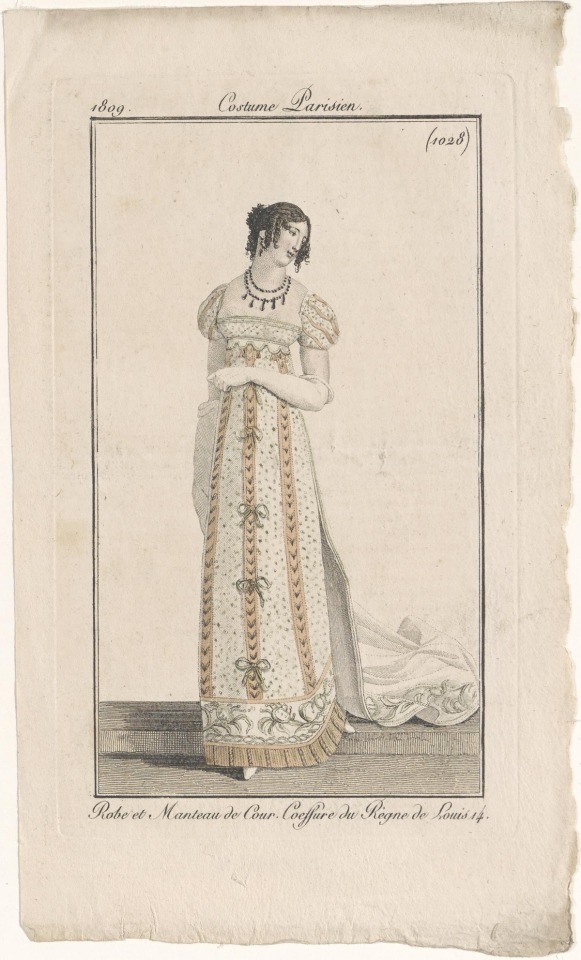


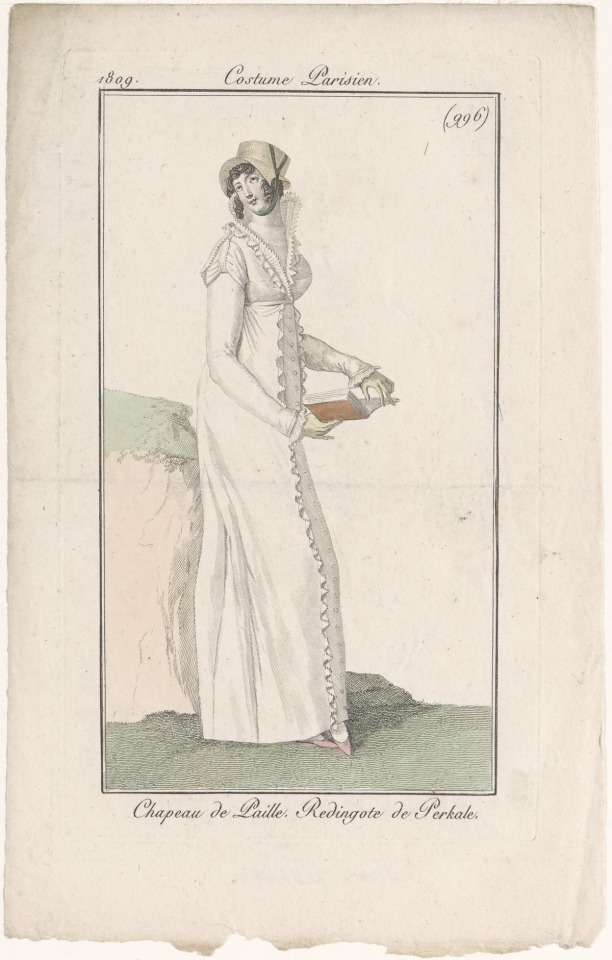
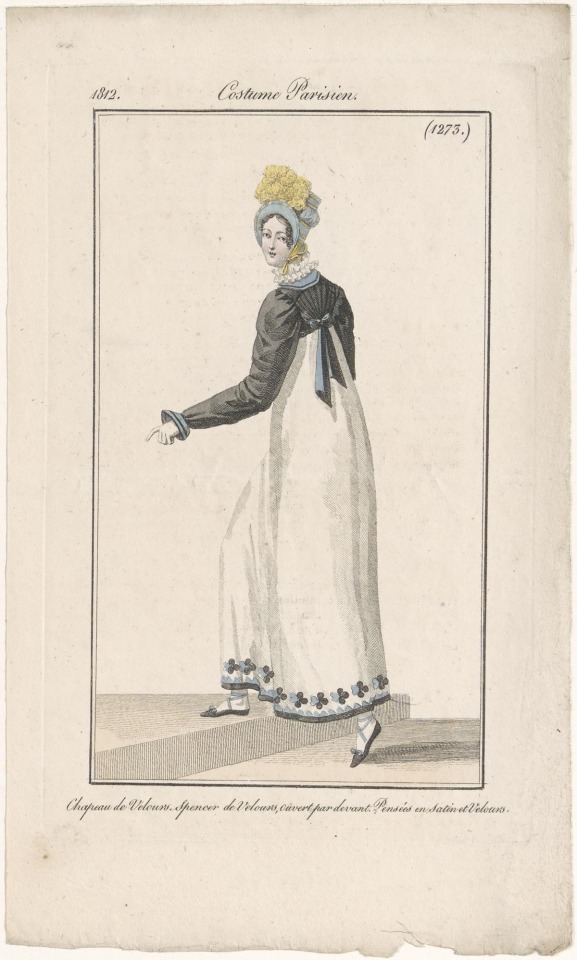

Fashion prints from Journal des Dames et des Modes
1808-1814, Napoleonic era
CMU
#fashion plates#fashion prints#prints#fashion#Journal des Dames et des Modes#Napoleonic era#napoleonic#napoleon#first french empire#napoleon bonaparte#1800s#1800s fashion#19th century fashion#historical fashion#history of fashion#art#centraal museum#Netherlands#french empire#mode#regency#regency era#regency fashion#Jane Austen#print#pretty#France#empire style#empire
251 notes
·
View notes
Text

A typical 1832 throuple from Journal des Dames et des Modes, showing the sexual dimorphism of the species.

Although the male is much smaller and relatively drab (despite his yellow gloves and patterned waistcoat); he will demonstrate his fitness as a mate with numerous dances.
#Eighteen-Thirties Thursday#1830s#fashion history#historical men's fashion#romantic era#1832#fashion plate#fashion#journal des dames et des modes#evening dress#day dress
167 notes
·
View notes
Text
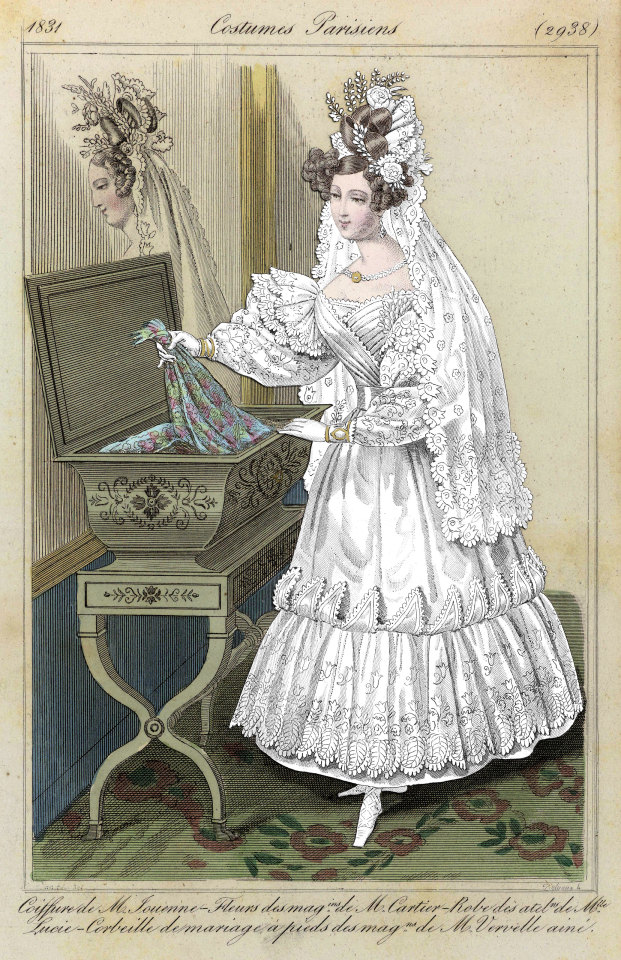
Journal des Dames et des Modes, Costumes Parisiens, 25 novembre 1831, (2938): Coiffure de M Jouenne. Fleurs des magasins de M Cartier. Robe des ateliers de Mlle Lucie. Corbeille de mariage à pieds des magasins de M Vervelle ainé.
Bride in frilly wedding dress and veil, from Lucie's studio. She is standing by a bridal basket. According to the caption, her 'coiffure' is from Jouenne and the flowers in the hairstyle are from Cartier. Print from the fashion magazine Journal des Dames et des Modes (1797-1839).
#Journal des Dames et des Modes#19th century#1830s#1831#on this day#November 25#periodical#fashion#fashion plate#color#description#rijksmuseum#dress#bridal#veil#gigot#Modèles de chez#Mademoiselle Lucie
87 notes
·
View notes
Text

Fashion Plate, 1797, French.
From Journal des dames et des modes.
Portraying a woman in a blue hat, white cotton dress and pink shawl.
BNF Gallica.
#1790s fashion plate#fashion plate#white#cotton#1790s france#fashion magazine#1797#1790s#French#France#french revolution#costumes parisiens#pink#blue#bnf gallica#Journal des dames et des modes#directoire
58 notes
·
View notes
Text
Etienne Drian, Journal des Dames et des Modes, Pagode, 1914
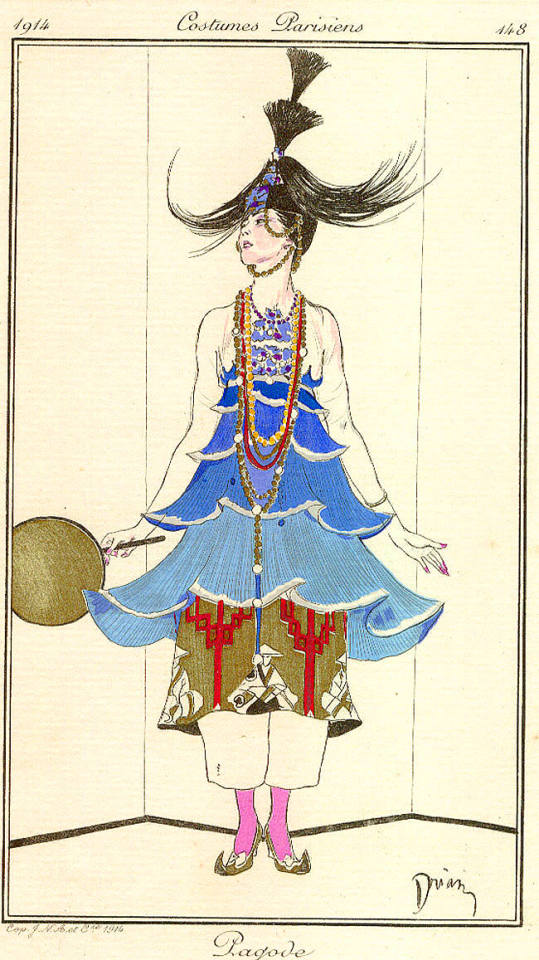
3 notes
·
View notes
Text
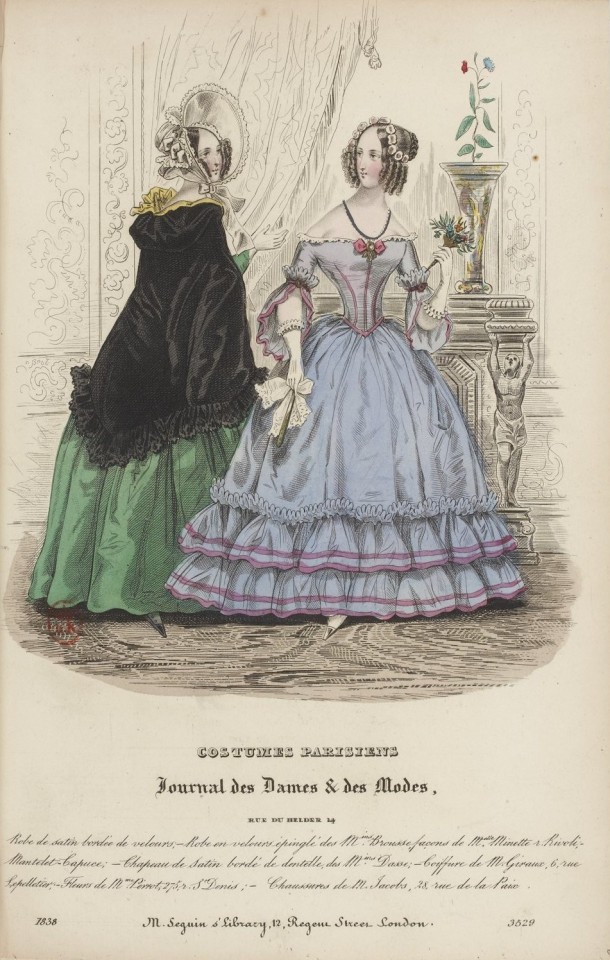
2 notes
·
View notes
Text
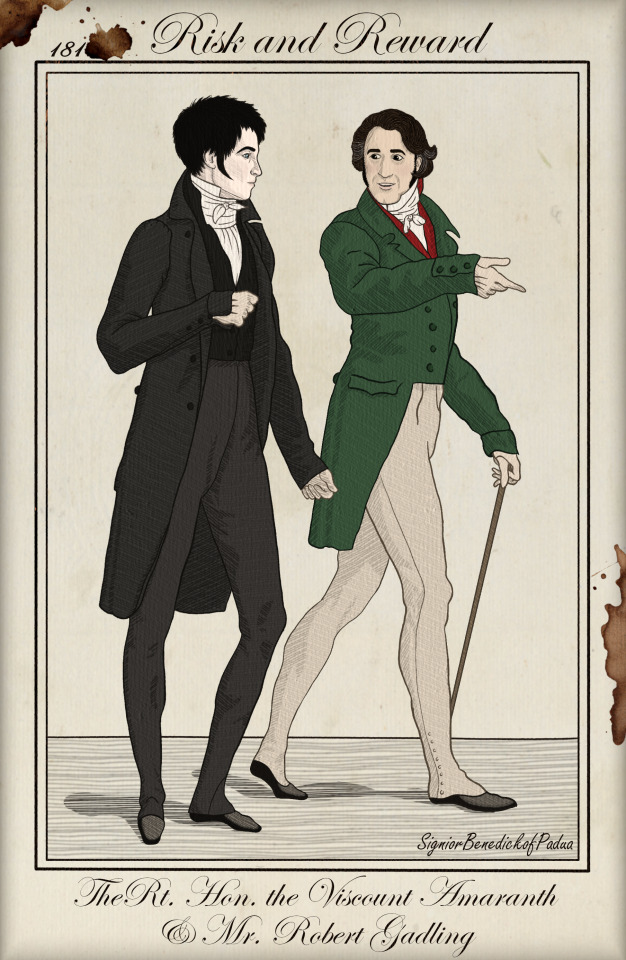
Risk and Reward on AO3
I got so excited about my own fic that I re-learned GIMP and awoke the dormant fanartist within me! It was great fun to finally pick up the stylus again, and I'm sure I'll keep returning to it more frequently in future.
Drawing is based on early 1800s fashion plates from the French fashion magazine Journal des dames et des modes. Clean version without texture, background and frame under cut.

#The Sandman#The Sandman art#The Sandman fanart#Dreamling art#Dreamling#my art#my fic#Risk and Reward fic#art for fic
172 notes
·
View notes
Text
I keep seeing people suggest Crowley's presentation in 1827 was feminine, and listen—headcanon what you want, I'm not your mom. But the justification is that he's supposedly dressed in feminine, as opposed to masculine, clothing? He isn't. You're just looking at Regency fashion with 21st-century eyes.

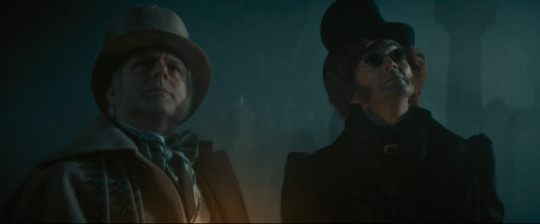
Both Aziraphale and Crowley are exemplaries of well-dressed gentlemen of the early 19th century, just in different styles.

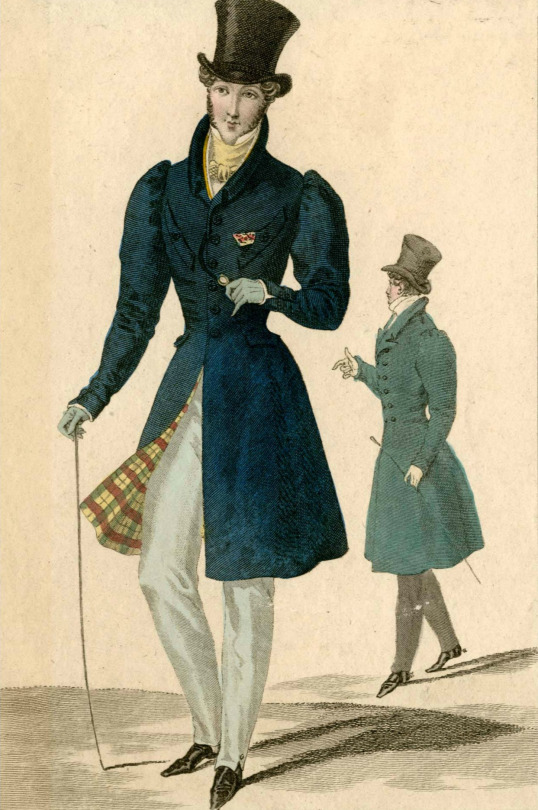
On the left, a many-caped greatcoat like the one Aziraphale is wearing; on the right, a coat with puffed sleeves and a narrow waist like the one Crowley is wearing. (Both images seem to originate from Journal des Dames et des Modes, 1811 and 1826, respectively.)
I also saw something about Crowley's fob watch actually being a chatelaine?

Again, I have to disagree. What Crowley's wearing just looks like a watch chain, which both men and women wore. What you can see is the chain and a charm at the end; the watch itself is tucked into a pocket (same as with Aziraphale's).
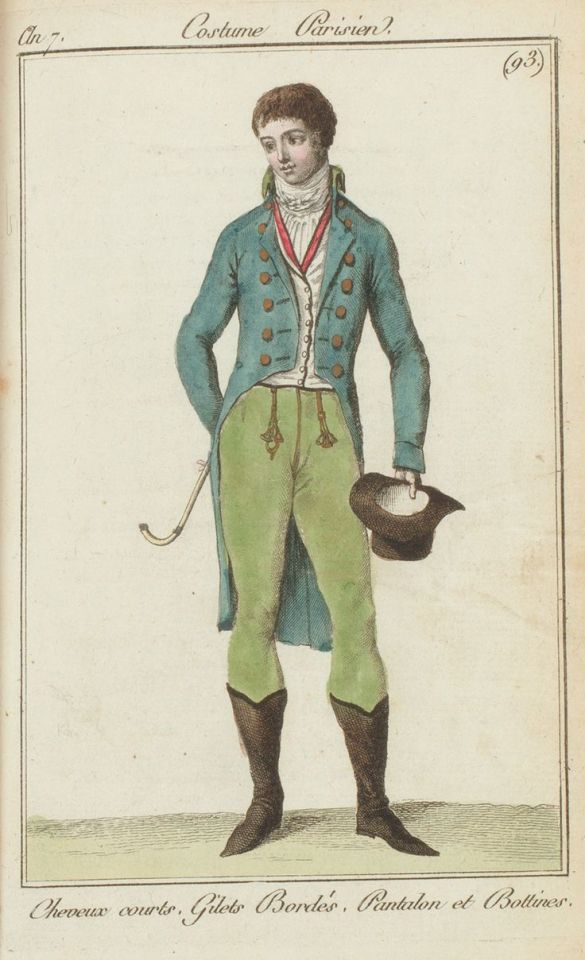

Watch chain (left; another plate from Journal des Dames et des Modes) vs. chatelaine (right, from here).
While a chatelaine could possibly refer to a decorative watch chain, the chatelaines specifically associated with women are the accessories worn by female heads of household or housekeepers (hence the name) to hold keys and other useful items. They could get quite elaborate. Crowley's doesn't look particularly like a chatelaine more than it looks like a watch chain, to me.
To sum up, there's not really anything I can see about Crowley's fashion choices in 1827 that specifically says "female presenting"; it all fits in with men's fashion of the time. You can headcanon whatever you want! But this particular era isn't one in which Crowley's wardrobe and styling definitively reads as feminine.
Note for a couple people with poor reading comprehension: TERFs are not welcome on this post. Fuck off.
#fynn posts#good omens#regency fashion#I am always Wary of wading into this especially because I've seen how spicy tw*tter-based fandom gets about interpretations#but it also irks me when people see men's fashion they don't understand and go “oh that's women's clothing”#so. yeah#1827? 1828? you know. around there. I missed that bit bc I was too busy failing to screenshot a gd watch chain#1828 was the westport murders but THAT'S ANOTHER POST
277 notes
·
View notes
Text

George Barbier, Costume Parisiens, Robe du drap borde d'un surlet couleur du rose, Peinture de roses au crochet, Journal des Dames et Des Modes Paris, 1912
#george barbier#illustration#1912#fashion illustration#Journal des Dames et Des Modes#paris#paris mode#belle epoque#la belle epoque#1910s fashion#illustrator#fashion art#art#pochoir#barbier#edwardian#edwardian era#Costume Parisiens#1912 illustrations#costume parisiens#des modes paris#paris fashion#chic#art history#fashion#fashion history
22 notes
·
View notes
Text
Women artists in Napoleonic France

(Young women copying: ‘Love begging Venus to forgive Psyche’ which was displayed at the 1808 Salon. Sketch by Georges Rouget)
Quotes from an article about women’s participation in the art world during the Napoleonic era.
Article:
Heather Belnap Jensen, “The Journal des Dames et des Modes: Fashioning Women in the Arts, c. 1800-1815,” Nineteenth-Century Art Worldwide 5, no. 1 (Spring 2006) (source)
“More and more women artists began exhibiting their work in public venues and receiving recognition for their contributions at this time. While only three women artists had participated in the 1789 biennial Salon, fifty participated in the Salon of 1806–an increase in women’s participation of over 1600 percent in seventeen years.”
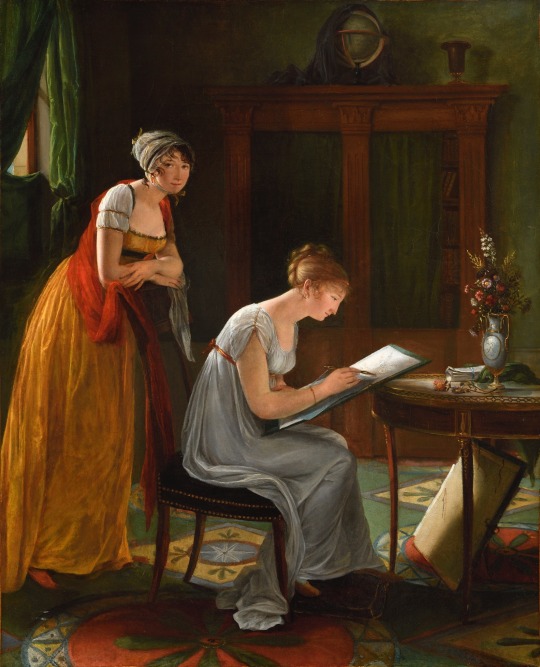
(Woman artist giving a drawing lesson — Self-portrait, 1810, by Louise-Adéone Drölling)
“We see a move away from the emphasis on the public sphere to the private space as motifs, intimating a valorization of a woman’s world. While history painting, which played such a crucial role in Revolutionary visual culture, remained the privileged genre at the turn of the century, the rise in portraiture, landscape, and genre painting in Napoleonic France indicates this shift in values.”
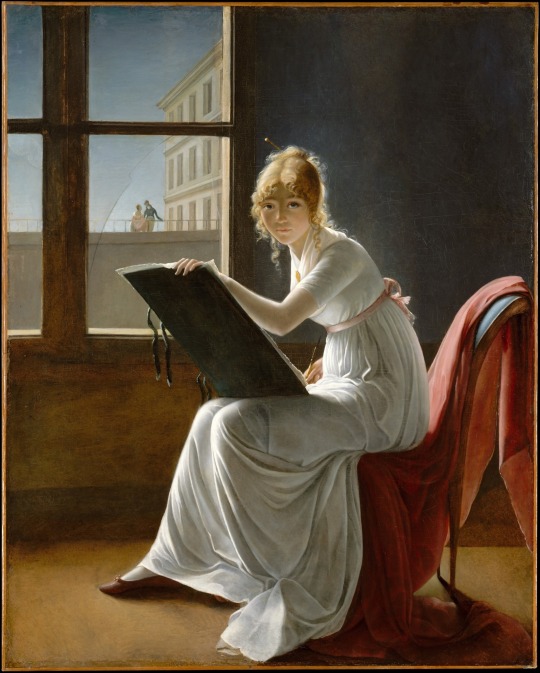
(Young Woman Drawing—Portrait of Charlotte du Val d'Ognes, 1801, by Marie-Denise Villers)
“Women’s journals, which often published art-related materials, have been largely overlooked in discussions of developments in late eighteenth-and early nineteenth-century French visual culture. This is surprising, given that bibliographies on art criticism of this period frequently cite items from these publications.”
One of the most influential women’s journal of the period was Journal des Dames et des Modes. It was created by Jean-Baptiste Sellèque and Pierre de La Mésangère in 1797 and continued until 1839.
“La Mésangère’s key collaborator during the Napoleonic period was a woman, Albertine Clément, née Hémery, a well-known figure in both journalistic and cultural circles in post-Revolutionary France, and that several women were regular contributors to this journal during this era.”
Annemarie Kleinert did a study on the journal:
“She determined that the journal targeted bourgeois women between the ages of 18 and 40 years old who could afford the annual subscription rate of 10 livres, and that the majority of subscribers during the period from 1800 to 1815 were from the provinces.”

(Portrait of a Young Woman Drawing Herself, early 1800s, by Louis-Léopold Boilly)
Interest from women in creating their own designs:
“Fashion plates that accompanied each issue of this journal gave visual testimony to this heightened interest in women’s artistic engagement. Indeed, women in fashion plates were sometimes presented in the act of sketching and drawing, as shown in a plate that appeared as an insert in an 1802 issue of the Journal des Dames et des Modes.”
The act of women creating art was compared to motherhood. In that way, women were encouraged to make art, but in terms which enforced traditional and patriarchal ideas:
“Furthermore, the vocabulary used by the author stresses the ways in which artistic creativity mirrors childbirth and elicits feelings of exaltation over one’s art that are similar to those evoked by motherhood when he writes that ‘she smiles at the objects which are born of her colors’ and calls the site of her production a ‘creative space.’”
There were opportunities for women to paint nude subjects for classical style art:
“Recent scholarship suggests that there were opportunities for such study in the Napoleonic era. By 1800, female students could attend anatomy classes given by the surgeon Sue and also by the École du Modèle Vivant at Versailles, and artist Adele Romilly reported that David, Régnault, and Guérin all provided mixed studios that offered courses on life drawing from the nude.”
One of the claims made against the women’s journals is that they were sexist. The author points out that it’s more complicated and not entirely true. The journals included laudatory reviews of paintings by female artists at the salons, biographies of women artists, such as Angelica Kauffmann, and published excerpts of pamphlets written by women, such as Angélique Mongez.
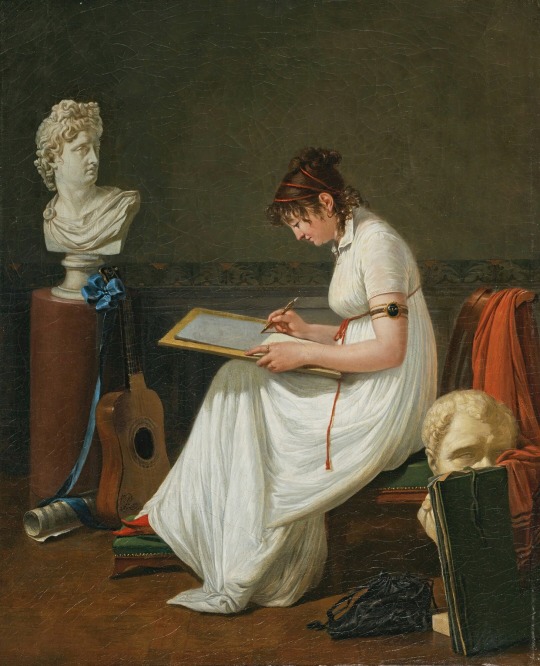
(Portrait of an Artist Drawing after the Antique, c. 1800s, Jean François Sablet)
However, the author also says there was a lot of anxiety about the increase in female participation in the art world, both as creators and as spectators. There were articles describing women at museums in derogatory terms. One in particular described a young girl being overcome by emotion at the sight of the statue of Apollo Belvedere and creating such a large scene that she had to be dragged away in tears.
These articles imply that women spectators had become dominant enough that it could inspire critics.
Women had become so important in the art world that a really unique phenomenon happened:
“Roger Bellet has demonstrated that there are known instances in late eighteenth-and early nineteenth-century France when men published under a female pseudonym.”
Many of the top artists who were admired in the era were women such as Élisabeth Louise Vigée-Lebrun, Marguerite Gérard, Constance Mayer, Adèle Romany, Adélaïde Labille-Guiard, Pauline Auzou, Jeanne-Elisabeth Chaudet, Marie-Guillemine Benoist, Constance Marie Charpentier and many others.
#art#women’s art#women artists#napoleonic era#napoleonic#mine#fashion#writing#first french empire#napoleon bonaparte#quotes#ref#reference#Journal des Dames et des Modes#19th century#1800s#fashion history#historical fashion#history of fashion#french empire#france#history#french revolution#frev#women’s history#womens art#women in art#women painters#fashion plates
61 notes
·
View notes
Text

1825 Fashion plate from "Journal des Dames et des Modes", Paris
(Design Museum of Barcelona)
141 notes
·
View notes
Text

Journal des Dames et des Modes, Costume Parisien, 1 décembre 1799, An 8 (175): Chapeau - Capote. Schall de Casimir. Collection of the Rijksmuseum, Netherlands
'Chapeau-capote' with a long transparent veil with a floral pattern covering the face. A long 'casimir' scarf around the neck. Dress with long sleeves and train. Flat shoes with pointed toes. The print is part of the fashion magazine Journal des Dames et des Modes, published by The print is part of the fashion magazine Journal des Dames et des Modes, published by Pierre de la Mésangère, Paris, 1797-1839.
#Journal des Dames et des Modes#18th century#1790s#1799#on this day#December 1#periodical#fashion#fashion plate#color#description#rijksmuseum#dress#shawl#veil#lace#Mésangère#cashmere
96 notes
·
View notes
Text

Fashion Plate, 1797, French.
From Journal des dames et des modes.
Portraying a woman in red and green turban, pale orange dress and pink shawl.
BNF Gallica.
#bnf gallica#fashion plate#1790s#1790s fashion plate#1790s france#costumes parisiens#diss#french revolution#french#France#fashion magazine#green#pink#orange#journal des dames et des modes#directoire
49 notes
·
View notes
Text

Journal des Dames et des Modes, 1912
#1912#1910s#history#fashion#fashion history#historical fashion#historical#antique#1910s fashion#1910s art#1910s dress#1900s#1900s fashion#history tag#fashion plate#vintage#vintage fashion#20th century fashion#early 20th century#20th century#antiquebee
143 notes
·
View notes
Text

2 notes
·
View notes